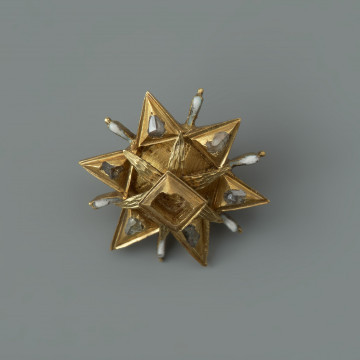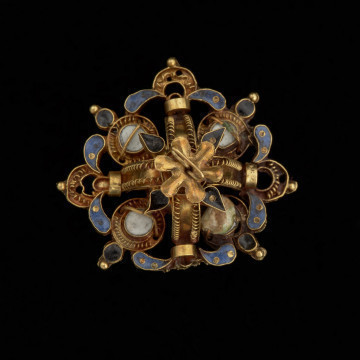
Star-shaped dress jewellery
nie po 1637
National Museum in Szczecin
Part of the collection: Jewels and costumes of Pomeranian dukes
The jewel in the form of a crucifix is characterised by the slenderness of form, emphasised by the cross decoration, with a white enamel central part and bands of black enamel on the sides. The figure of Christ is almost entirely covered in enamel, except for the hair, beard and hip ornament, which were left in gold. The elongated body proportions, the gently curved figure, the way the legs are positioned and the low-hanging hip ornament all refer to the type of Crucified Christ figures developed by the Florentine sculptor Giovanni da Bologna (Giambologna). The Mannerist representation of the dead Christ was popular in the last decade of the 16th and early 17th centuries thanks to the casts of Antoni Susini, who collaborated with Giambologna, and was popular among others in the Augsburg community.The jewel was excavated from the sarcophagus of Duchess Erdmutha of Brandenburg (1561-1623), a wife of John Frederick, on the occasion of the opening of the crypt under the Castle Church in Szczecin in 1862. There can be no mistaking the fact that Erdmutha's burial instructions, written in 1619, list the clothes and jewels she was to be buried in and mention 'one gold crucifix set with diamonds and rubies', and the other precious objects found in her coffin: a gold chain with rectangular links, a pair of gold bracelets with heart-shaped links, and seven rings, including a wedding ring with thirteen diamonds. The authorities of the Pomeranian Province offered the jewels to Erdmutha's closest relatives and at the same time to the legal heirs of the dukes of Pomerania - the Berlin Hohenzollerns, represented by King William I of Prussia. Until the Second World War, the jewels were in the collection of the Hohenzollernmuseum in Schloss Monbijou in Berlin, and later they were considered lost. The appearance on the antiquarian market of a jewel in the shape of a cross, purchased for the Museum's collection in 2008, gives hope that other pieces of the Duchess' jewellery will also be found.
Monika Frankowska-Makała
Other names
cross of Princess Erdmutha
Author / creator
Dimensions
cały obiekt: height: 9 cm, width: 5,6 cm
Object type
pendant, jewellery
Creation time / dating
Creation / finding place
Identification number
Location / status

nie po 1637
National Museum in Szczecin

nie po 1637
National Museum in Szczecin

około 1600
National Museum in Szczecin
DISCOVER this TOPIC
Museum of King Jan III's Palace at Wilanów
DISCOVER this PATH
Educational path